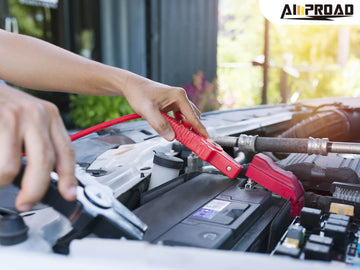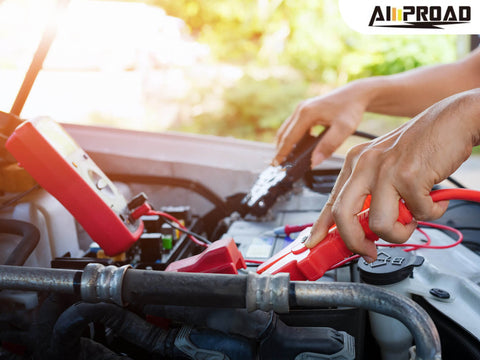Can I Use a Jump Starter with Lower Voltage Output if My Vehicle's Battery Is Dead?
Apr 19, 2024

Jump starters are portable devices designed to provide a temporary boost of power to a vehicle's dead battery, allowing the engine to start. They typically consist of a battery pack and jumper cables, which are connected to the vehicle's battery terminals to transfer power. Jump starters are invaluable tools for drivers facing battery-related issues, offering a convenient solution for jump-starting vehicles without the need for another vehicle or access to mains power.
Voltage compatibility is crucial when using jump starters. The voltage output of the jump starter must match or exceed the voltage requirements of the vehicle's battery to ensure safe and effective jump-starting. Using a jump starter with a lower voltage output than the vehicle's battery can lead to ineffective jump-start attempts, potential damage to the vehicle's electrical system, and safety hazards for both the vehicle and the user.
The question of whether a jump starter with lower voltage output can be used on a dead vehicle battery is a common concern among drivers. In the following sections, we'll delve into the risks and considerations associated with using a jump starter with lower voltage output and provide insights to help you make informed decisions when jump-starting your vehicle.
What Are Jump Starters
Jump starters are essential tools for drivers facing a dead battery, providing a quick and efficient solution to get back on the road. Let's explore what jump starters are and how they work.
Definition of Jump Starters and How They Work
Jump starters, also known as booster packs or battery boosters, are portable devices designed to provide a temporary surge of power to a vehicle's dead battery, allowing the engine to start. They consist of a rechargeable battery pack housed in a compact casing, often equipped with built-in jumper cables.
Using a portable battery booster is a straightforward process. First, ensure both the jump starter and the vehicle are turned off. Then, connect the positive (+) clamp of the jumper cable to the positive terminal of the dead battery and the negative (-) clamp to a suitable grounding point on the vehicle's chassis, such as an unpainted metal surface. Once properly connected, turn on the jump starter and attempt to start the vehicle. If successful, allow the engine to run for a few minutes to recharge the battery.
Explanation of the Typical Voltage Output of Jump Starters
Jump starters typically have a voltage output ranging from 12 volts to 24 volts, depending on the model and intended application. Most passenger vehicles use a 12-volt electrical system, making 12-volt jump starters the most common choice for everyday drivers. However, larger vehicles such as trucks or RVs may require higher voltage jump starters to provide sufficient power.
Importance of Matching Voltage Output to the Vehicle's Battery Specifications
Matching the voltage output of the jump starter to the vehicle's battery specifications is crucial for safe and effective jump-starting. Attempting to jump-start a vehicle with a jump starter that has a lower voltage output can lead to ineffective jump-start attempts and potential damage to the vehicle's electrical system. Conversely, using a battery booster with a higher voltage output than the vehicle's battery can also pose risks and may result in damage to sensitive electronic components.
Understanding how to boost a car safely and effectively with a jump starter is essential for every driver. By following proper procedures and ensuring voltage compatibility, drivers can rely on jump starters to provide a reliable solution for dead battery emergencies.
Analysis the Risks of Using a Jump Starter with Lower Voltage Output

Using a jump starter with lower voltage output than your vehicle's battery specifications can pose several risks and drawbacks, which we'll analyze below:
Potential Damage to Vehicle Electronics and Battery
The primary risk of using a jump starter with lower voltage output is the potential for damage to the vehicle's electronics and battery. Modern vehicles are equipped with complex electronic systems that are sensitive to fluctuations in voltage. Attempting to jump-start a vehicle with insufficient voltage can result in voltage spikes or irregularities that may damage electronic components such as the engine control unit (ECU), onboard computer systems, and even the battery itself. This can lead to costly repairs and potential safety hazards while driving.
Reduced Effectiveness in Jump-Starting a Dead Battery
Another risk of using a jump starter with lower voltage output is reduced effectiveness in jump-starting a dead battery. The purpose of a jump starter is to provide a surge of power to the vehicle's battery to crank the engine and start the vehicle. However, if the jump starter cannot deliver enough voltage to the battery, it may struggle to initiate the starting process, resulting in failed jump-start attempts. This can leave you stranded with a vehicle that refuses to start, necessitating alternative solutions and potentially causing inconvenience and frustration.
Safety Concerns for Both the Vehicle and the User
Using a jump starter with lower voltage output also raises safety concerns for both the vehicle and the user. A jump starter that cannot provide sufficient voltage may not only fail to start the vehicle but also pose safety risks such as overheating, short circuits, or even electrical fires. Additionally, repeated unsuccessful jump-start attempts can drain the battery further, increasing the likelihood of battery damage and rendering it unusable. Furthermore, mishandling or improper connection of jumper cables can result in electrical shocks or damage to the vehicle's electrical system, posing risks to the user's safety.
Factors to Consider
When selecting a jump starter for your vehicle, it's essential to consider several factors to ensure safe and effective jump-starting, including:
Compatibility with Specific Vehicle Models and Battery Types
Not all jump starters are created equal, and compatibility with specific vehicle models and battery types is crucial. Different vehicles may have varying voltage requirements, and certain battery types may require specific charging protocols. Before purchasing a jump starter, ensure that it is compatible with your vehicle's make, model, and battery specifications to avoid potential damage or ineffective jump-start attempts.
Manufacturer Recommendations and Guidelines
Manufacturers often provide recommendations and guidelines for selecting the appropriate jump starter for your vehicle. These guidelines may include voltage compatibility requirements, recommended jump-starting procedures, and safety precautions. It's essential to follow these recommendations closely to ensure optimal performance and safety when jump-starting your vehicle.
Alternatives to Using a Jump Starter with Lower Voltage Output
If you find yourself in a situation where a jump starter with lower voltage output is the only option available, consider alternative solutions to jump-start your vehicle safely. One option is to use a higher voltage jump starter that is compatible with your vehicle's battery specifications. Alternatively, you can seek assistance from roadside assistance services or other drivers with compatible jump starters. Additionally, some versatile jump starters, such as the AMPROAD jump starter, offer adjustable voltage output settings, allowing you to customize the output to match your vehicle's requirements.
By considering these factors and exploring alternative solutions, you can ensure a safe and effective jump-starting process for your vehicle, minimizing the risk of damage and maximizing the likelihood of success. Remember to always prioritize safety and follow manufacturer recommendations and guidelines when using jump starters.
Expert Advice and Recommendations

Insights from automotive professionals and experts:
Trying to jump-start your car with a lower voltage output jump starter is generally not recommended by automotive professionals and experts. Here's why:
Insufficient Power: A jump starter with a voltage output lower than your car battery's normal voltage (typically 12 volts) might not provide enough power to crank your engine. This can lead to failed jump-start attempts and leave you stranded.
Potential Damage: The mechanics at Scotty Kilmer's channel warn that while the voltage might not be a huge concern initially, forcing a low-voltage jump starter on a dead battery could potentially damage your vehicle's electrical system.
Guidelines for selecting the appropriate jump starter for your vehicle:
- Match the Voltage Output: It's crucial to choose a jump starter with a voltage output that matches your car battery's voltage. Most car batteries are 12 volts, so a 12-volt jump starter is ideal.
- Consider Cranking Power: It's also recommend looking at the cranking power (measured in amps) of the jump starter. A higher cranking power ensures your jump starter can deliver the necessary current to overcome the initial resistance of a dead battery.
- Vehicle Engine Size: Bigger engines generally require more cranking power. Opt for a jump starter with a higher cranking power rating for larger vehicles like SUVs or trucks.
Safety Tips for jump-starting a vehicle battery:
Always prioritize safety when jump-starting your car. Here are some essential tips from mechanics based on the video of Scotty Kilmer:
- Park Properly: Ensure both vehicles are turned off and parked with parking brakes engaged. Make sure the vehicles are not touching to avoid electrical shorts.
- Double-Check Connections: Positive (red) cable goes to the positive terminal of the dead battery, and negative (black) cable goes to a designated grounding point on the dead vehicle, far from the battery.
- Start the Donor Car First: Start the vehicle with the good battery and let it run for a few minutes to allow its battery to recharge slightly.
- Attempt to Start the Dead Car: Then, try starting the car with the dead battery. If it starts after a few seconds, remove the cables in reverse order (negative first, then positive).
- Don't Force It: If the engine doesn't crank after several attempts, avoid forcing it. This could damage the starter motor or other electrical components. It's best to call for professional assistance.
FAQs / People Also Ask
FAQ: Can I use a jump starter with lower voltage output on my vehicle's dead battery?
Answer: It's not recommended to use a jump starter with lower voltage output than your vehicle's battery specifications. Doing so can lead to ineffective jump-start attempts, potential damage to your vehicle's electronics, and safety hazards. It's crucial to use a booster batterie with voltage output that matches or exceeds your vehicle's battery specifications for safe and effective jump-starting.
FAQ: What are the risks of using a jump starter with lower voltage output?
Answer: Using a jump starter with lower voltage output can pose several risks, including potential damage to your vehicle's electronics and battery, reduced effectiveness in jump-starting a dead battery, and safety concerns for both the vehicle and the user. It's essential to ensure voltage compatibility and use appropriate jump-starting equipment to avoid these risks.
FAQ: How do I know if a jump starter is compatible with my vehicle's battery?
Answer: Before using a jump starter, check your vehicle's battery specifications and compare them to the voltage output of the jump starter. Most vehicles use a 12-volt electrical system, so a 12-volt jump starter is typically suitable. However, for vehicles with different voltage requirements, ensure that the jump starter's output matches your vehicle's specifications to avoid compatibility issues.
FAQ: Are there alternative solutions if I only have a jump starter with lower voltage output?
Answer: If you only have a jump starter with lower voltage output available, consider alternative solutions such as using a higher voltage jump starter that is compatible with your vehicle's battery specifications. Additionally, you can seek assistance from roadside assistance services or other drivers with compatible jump starters to safely jump-start your vehicle.


